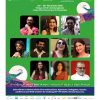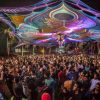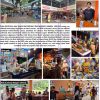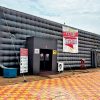Goa is abuzz with excitement as vintage bike and car owners, users, collectors and fans are decking […]

MUD AND MELODY: NISARGA ART HUB AND THE POETRY OF PLACE
Uncategorized November 28, 2025By Prema Viswanathan
IN a cultural landscape increasingly defined by large, corporate-backed art complexes, a modest structure in Angamaly, Kerala, is quietly redrawing expectations.
The Nisarga Art Hub—conceived by engineer-turned-Carnatic vocalist KS Vishnudev and his partner Lakshmi V, who is herself a singer —is not a conventional performance venue. Nor is it an institutional art centre in the usual sense. Instead, it is something more intimate, more vulnerable, and more daring: a home that doubles as a stage, and a stage that folds back into lived life.
Set near the edge of paddy fields where the wind moves like a subtle percussion, Nisarga feels less like a building and more like a natural extension of the earth. The walls appear to breathe mud and memory. The name – Nisarga, which means nature or natural state in Sanskrit – encapsulates this vision. The roofline echoes the vernacular silhouette of Kerala homes, yet breaks into unexpected geometries that catch light like a sudden raga variation.
Designed by Vinu Daniel and Oshin Mariam Varughese, the architecture is ecological, tactile, and unafraid to reveal its raw edges. It stands as a reminder that art does not always require grandeur; sometimes, the most powerful gestures emerge from intimacy, vulnerability, and the courage to stay small.
It is easy to miss Nisarga from a distance. We ourselves had a tough time getting to it. That, in many ways, is the point. “We weren’t trying to build a landmark on the inherited property,” says Vishnudev. “We wanted a space where art could breathe—quietly, without the pressure of perfection.”
The building’s material language—raw debris walls, terracotta, skylit slopes—signals not a retreat from modernity but a rethinking of what cultural spaces can be in a region already rich with artistic traditions, yet underserved by accessible and aesthetically sensitive venues.
Early Roots: A Childhood Shaped by Listening
THE origins of Nisarga’s ethos can be traced back to Vishnudev’s early years. His father, Sasi KG, recalls a childhood steeped in an insatiable passion for music. “Though I myself wasn’t trained in Carnatic music,” he says, “I didn’t want my son to curb his talent. There weren’t many venues in our hometown for pursuing classical music, so we would travel by bus to Ernakulam and Thrissur just to listen to kutcheries.”
Even as a schoolboy, Vishnudev insisted on attending recitals—sometimes even on the eve of examinations. “He would never want to miss a performance by a renowned musician,” Sasi says. “He also listened constantly to recordings by famous artists.” That kelvi nyanam – the skill of learning by listening – contributed to making Vishnudev the musician he is today.
That discipline and devotion also formed the backbone of the creative force he would eventually become.
A Roof That Invites Participation
AT first glance, the most distinctive feature in Nisarga is the roof. Traditional Kerala homes use the sloping roof as protection; Nisarga turns it into an amphitheatre. Terracotta and toughened glass steps rise into the treeline, inviting audiences to sit, listen, and look outward to the fields.
The idea started casually and was the brainchild of the two architects. “It was Vinu Daniel who suggested —why not use the roof? Why shouldn’t architecture participate in the performance?,” says Lakshmi.
The result is a dual-use form: functional roofing and open-air stage, a structure that becomes performative in itself.
This instinct—to repurpose the familiar—guides the entire project. Shuttered debris walls made from construction waste give the building a rugged ecological honesty. Skylights break open the roofline, softening the interior with shifting daylight. The palette remains earthy, tied firmly to the land it inhabits.
A Home That Lives With Art
Where many “art + living” projects maintain clear boundaries between domesticity and public programming, Nisarga does the opposite. Living and hosting are not separate modes but entwined rhythms.
“This is not a venue you rent,” says Lakshmi. “It’s a place you enter—and that means entering our lives a little too.”
Lakshmi manages this porousness, balancing hospitality with the demands of a family home. Their partnership gives the hub its character: open, yet grounded, experimental, yet deeply personal.
Art, Collaboration and the Pandemic
VISHNUDEV’S passion for music has always been relentless, and this intensity continued even during the Covid-19 lockdowns. In that period of global uncertainty, he and Lakshmi released their first independent single, Vizhi. The collaboration met with an enthusiastic response and quickly travelled across social-media circuits.
“The reception to Vizhi was unexpected,” recalls Lakshmi. “People connected with its simplicity, its sincerity. That gave us confidence.”
That confidence carried directly into their next collaboration—the creation of the Nisarga Art Hub itself.
Where Big Names and New Voices Share the Same Stage
ALTHOUGH small, Nisarga has already hosted prominent names in the Indian music ecosystem. Renowned musician and writer TM Krishna spent two days this May conducting a workshop and singing — an event that drew students, musicians, and community members into close dialogue. As Sasi reveals, for Vishnudev, TM Krishna was an inspiration from his younger days, so for him and Lakshmi, it was a privilege to welcome him into Nisarga.
Harish Sivaramakrishnan, the celebrated vocalist leading the Carnatic-fusion band Agam, performed at Nisarga, the thrum of the drums echoing into the night fields. “ He told us he loved the intimacy of the experience and said he felt like he was performing in his own living room,” says Lakshmi.
Yet the significance of these appearances lies not in prestige but in coexistence. The same stage welcomes emerging vocalists, lesser-known percussionists, indie musicians, and children testing their first performance. “We didn’t want this to become a curated elite space,” says Lakshmi. “A young musician should feel as welcome as someone famous.”
In November this year, Nisarga was the venue for Songs and Stories, a songwriting and music workshop conducted by Shakthisree Gopalan and Mathan MJ. It followed Swaras and Beyond, a joint singing and jamming session in late October led by young singer Aadithyadev Punnayurkulam. Both were immensely popular and received a shoutout in social media. And in early October Nisarga showcased a soulful rooftop concert by Jeremiah de Rozario. “I felt I was singing to the sky”, said Jeremiah. “And indeed I was.”
Before that, in July, Nisarga resonated with the sounds of Dhrupad as its well known exponent Niloy Ahsan initiated young aspirants into the intricacies of the ancient musical form.
And in December last year, Nisarga hosted an event that dissolved the boundary between painting and music, as renowned artist Gireesan Bhattadiripad allowed his brush to be inspired by the music of young Carnatic vocalist Vignesh Ishwar and his accompanists. Standing witness to the osmosis between music and the visual arts that transpired that evening is a painting that now adorns the living room at Nisarga.
A Soundscape Shaped by Soil and Sky
ACOUSTICALLY, the space behaves like no urban concert hall. The mud walls absorb and soften sound; the roof amplifies and disperses it. “There’s nowhere to hide,” says Lakshmi. “You are close to your audience, and the building makes you honest.”
Looking Ahead: Broadening the Cultural Spectrum
“KERALA’S cultural wealth isn’t limited to classical music,” says Vishnudev. “Our indigenous forms, our regional theatre, our craft traditions—they deserve a home too.”
Future plans include residencies for practitioners of tribal and folk music, small-format theatre engagements, visual arts and craft-centric events, storytelling evenings rooted in local memory as well as performance labs for younger artists.
Strengths and Vulnerabilities
NISARGA’S strengths—its intimacy, ecological vision, and flexible programming—come with trade-offs. Although built with sustainable materials, the cost of maintenance is quite steep. And then there is the effort to make the performances self-sustaining. “It’s not always easy,” says Lakshmi, who bears the brunt of organising and marketing the events. “It’s all very new to us. But we are slowly learning how to make it work, with the abundant love and support we receive from the community.”
“Any sincere experiment will have vulnerabilities,” says Vishnudev. “But that’s the point. If you remove all risk, you remove the possibility of genuine connection.”
Why Nisarga Matters
NISARGA counters the idea that cultural impact depends on scale or capital. It suggests that meaningful artistic ecosystems can emerge from modest footprints, regionally grounded design, and committed practitioners.
“If Nisarga inspires even a handful of similar spaces in Kerala,” says Lakshmi, “it means we’ve added something—not to the art world, but to its possibilities.”
Nisarga Art Hub embodies a rare convergence: low-carbon architecture, democratic programming, intimate scale, and a lived-in environment where art is not an event but a continuous presence. As Vishnudev puts it: “We aren’t trying to build an institution. We are trying to build a conversation—with artists of all disciplines, with the land, with our community. Everything else will grow from there.”















